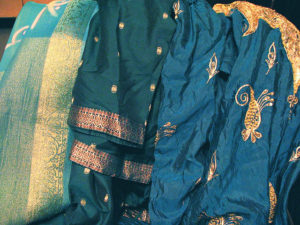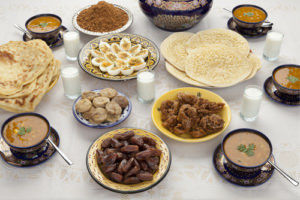Every year, Muslims celebrate Eid Al-Fitr which marks the end of Ramadan. This celebration is the most festive of the Eids, and takes place over three days. Preparing for Eid means wearing your nicest clothes and indulging in various festivities. Although celebrations differ based on culture, the significance of this holiday remains constant across borders. Here are four fascinating festivities that are typically celebrated on Eid Al-Fitr!
- Festive Wear: Dress your Best!

Wearing your finest, most ornamental clothing is common on Eid Al-Fitr. For example, in the Middle East and other Islamic states, women generally wear long gowns or embellished abayas, while in Southeast Asia, women generally wear salwar kameez. It is also typical for western or modern Muslims to wear formal western attire. Alternatively, men either wear thawab, a festive pant suit, or formal western clothes.
- Common Festivities: Eat, Laugh, and Dance
During this celebratory time, Muslims gather for parties during the day and night. Typically large feasts are arranged where family and friends come and indulge in their country’s cultural cuisine. If you travelling abroad in a predominantly Muslim country, you may see festive lights and ornaments around the city. It is common to give gifts to those observing Eid, so, if you work with Muslim counterparts, a box of dates is a nice gesture. Additionally, prayers are often arranged and friends and family commonly pray together. After dinner, friends  and family have a good time, chat, and enjoy the feast. For example, Chaand raat, or “night of the moon,” an Urdu phrase coined in the Indian subcontinent, includes dancing, cultural foods, and henna hand art.
and family have a good time, chat, and enjoy the feast. For example, Chaand raat, or “night of the moon,” an Urdu phrase coined in the Indian subcontinent, includes dancing, cultural foods, and henna hand art.
- Charity: Giving back
Giving back is a part of the celebration! During Ramadan, Zakat, or giving charity to the less fortunate is an important part of the holiday. These practices are further encouraged on Eid Al-Fitr by giving both food and money to underserved communities. Although it is typical to indulge with friends and family, giving to those who cannot indulge is recommended and remains a large part of observing the Muslim faith. When participating in an Eid celebration with Muslim friends, it is also common for adults to give children Eidi, or  ‘goodwill’ money as a part of celebrating.
‘goodwill’ money as a part of celebrating.
- Common Phrases: Greetings and Praises
Because Muslims worship worldwide, the way people meet and greet may differ depending on the person’s native language. That being said, some globally known Eid sayings in Arabic are listed below:
- From greeting elders to children, Eid Mubarak! is perhaps the most common saying “Eid Mubarak!” is translated to, “Blessed Eid!”
- Secondly, Eid Saeed! or “Happy Eid!” is also a pleasant way to greet others on this day; and
- Thirdly, Kul ‘am wa enta bi-khair or “May every year find you in good health!” is sometimes used more formally among Muslims.
Mark the end of Ramadan well, and celebrate happily and respectfully. Indulge in festivities, and also remember to give back.
-Eid Mubarak friends!
Sharon Schweitzer and Sophia Syed co-wrote this article. Sharon Schweitzer, J.D., is a cross-cultural trainer, modern manners expert, and the founder of Protocol & Etiquette Worldwide. In addition to her accreditation in intercultural management from the HOFSTEDE centre, she serves as a Chinese Ceremonial Dining Etiquette Specialist in the documentary series Confucius was a Foodie, on Nat Geo People. She is the resident etiquette expert on two popular lifestyle shows: ABC Tampa Bay’s Morning Blend and CBS Austin’s We Are Austin. She is regularly quoted by BBC Capital, Investor’s Business Daily, Fortune, and the National Business Journals. Her Amazon #1 Best Selling book in International Business, Access to Asia: Your Multicultural Business Guide, now in its third printing, was named to Kirkus Reviews’ Best Books of 2015. She’s a winner of the British Airways International Trade Award at the 2016 Greater Austin Business Awards.
Sophia Syed is a Spring 2017 cross-cultural communication intern with Protocol & Etiquette Worldwide. As a third-culture kid who has lived abroad in countries including Dubai, Jamaica, and Singapore, she has interacted with many different nationalities in both a professional and personal setting. She was a Dubai student representative for the Global Issues Network Conference in Luxembourg in the Spring of 2015, where she discussed economical, environmental and human rights issues with representatives of 70 countries. She currently attends the University of Texas at Austin as a double major in Corporate Communication and Communication Sciences. Her most recent project is working with the Room to Read organization, which raises funds for children’s literacy efforts and girls’ education in Asia and Africa.
Photo Credit: Litlnemo| Flickr , USDA|Flickr

Leave A Comment